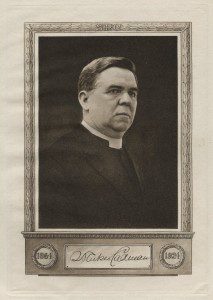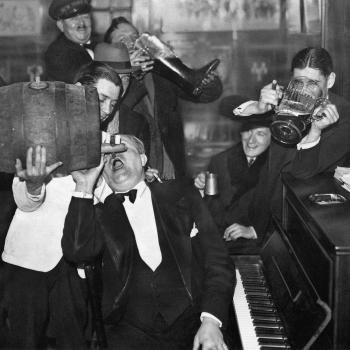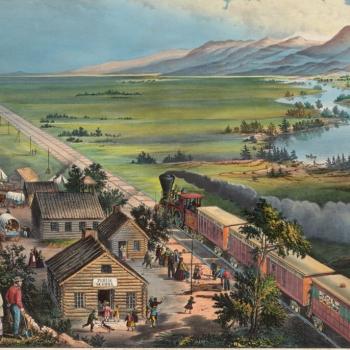…it seems as if all the hands in the world are touching or trying to touch the new Christ and that the new Cross is the Plane… (Harry Crosby, eyewitness to Charles Lindbergh’s 1927 landing in Paris)
Transoceanic travel has become so commonplace that I’m not sure we can fully appreciate what Charles Lindbergh did on May 20-21, 1927, when he became the first person to complete a solo, nonstop, transatlantic flight. But at the time, people had to use the language of divinity to explain what that flight meant to them.
Lindbergh’s first biographers called him “a demi-god, the personification of human achievement.” (As we’ve seen, such attempts to “deify” Lindbergh as just such a “demi-god” helped prompt Silas Bent’s warning of the rise of “American paganism.”) But others doubted that human effort alone was responsible. Lindbergh’s own 1927 account, “We,” is impossibly matter-of-fact, but the afterword by Fitzhugh Green reported that “[m]any said that [Lindbergh’s] sudden meteor-like appearance from obscurity was an act of Providence.” One such observer was the American ambassador who hosted Lindbergh in Paris. “While I am not a deeply religious man,” said Myron T. Herrick in a ceremony at the Hotel de Ville, “I recognize that Captain Lindbergh’s great achievement is the produce of divine inspiration. Nothing else can explain his success.”
Ernest Hemingway, who wasn’t at Le Bourget, called Lindbergh an “angel.” Fellow expat Harry Crosby, who was, “the new Christ.”
So how did Christian leaders respond to the providential appearance of this modern demi-god, the “new Christ” whose sudden advent was covered by mass media? (Given that Lindbergh arrived in Paris on a Saturday, one imagines many sermons being frantically re-written as America’s evening papers reported the astonishing news.) It’s a question I need to research further, but let me share at least a glimpse of the Christian response in America’s largest city.
Hard as it may be to believe ninety years later, in 1927 the New York Times reported on sermons by leading pastors. Its archives from that year contain dozens of examples of Christian reflection on Lindbergh, primarily from May 22nd or June 12th (“unofficially but almost universally” called “Lindbergh Sunday,” in anticipation of the flyer’s New York parade the following day). Most of the sermons were delivered in Episcopal, Methodist, Congregationalist, and other mainline Protestant churches, but the spectrum stretched all the way from the Unitarian theologian Charles Francis Potter to John Roach Straton, the staunchly conservative pastor of Calvary Baptist who had held a series of debates with Potter at Carnegie Hall in 1923-1924.
To a man (and they were all men), these preachers fell over themselves to praise Lindbergh.
Why? What made him so praiseworthy?
First and foremost, the Minnesotan appeared to clergy like the Methodist pastor Christian Reisner to be a young man of irreproachable character, “built in the school of hard work, poised by faithfulness and brightened by the spirit of service.” At Saint Thomas’, a historic Episcopal church on Fifth Avenue, Harold Gibbs proclaimed American pride in the flyer’s
bravery, his manliness, his calm poise and balance, his frankness and honesty, his devotion to an ideal and his cleanness of mind and body…. These are qualities which the Christian Church has tried to build up in her children. These are the qualities of a Christian gentleman. What we admire most in him is that he is the product of Christian teaching and the Christian religion.

If he was as humble as other preachers claimed, one wonders how Lindbergh felt while S. Parkes Cadman, the president of the Federal Council of Churches, lavished praise on him before 200,000 onlookers in Brooklyn’s Prospect Park: “We value you most of all for your matured wisdom, gracious deference, inborn tact, simplicity and inflexibility of purpose. It is your indefinable moral superiority that draws out souls.”
The dean of New York’s Episcopal cathedral, Howard Chandler Robbins, attributed Lindbergh’s success to “[d]iscipline, the self-discipline of years….” It was a rare word from that pulpit that Straton might have endorsed; the Baptist preacher boasted that “Lindbergh’s long flight across land and sea was sustained only by his own intrepid will power.” No fundamentalist was going to go as far as Straton’s sparring partner Potter (“We earth-bound spirits rise in sympathetic exultation when one of our number transcends some common limitation and lifts a whole race with him in his epic achievement”), but Straton, a staunch prohibitionist, was reminded of a famously abstemious Old Testament hero :
Lindbergh’s achievement illustrates as well, like the life of Daniel, the advantages of clean living and a pure heart. Like Daniel, this splendid, smiling American boy has refused to defile his body with strong drink, or by smoking, profanity, or other such abuses. Thanks to a noble mother’s example, and the influences of her Christian ideals, this young man, in the midst of the temptations and moral dangers of today, has maintained his life on a clean and wholesome basis.
For other clergy, it was the evident failure of Prohibition that made Lindbergh notable; they were relieved to see a young American defy Jazz Age stereotypes. John L. Davis, a Methodist, held up Lindbergh’s flight as “a rebuke to those youths who think of nothing but necking and drinking parties because he has shown what can be done through proper application of a stalwart character.” In Lindbergh, Robert Norwood (St. Bartholomew’s Episcopal) told an imagined European, “you have the representative of American manhood. America is not in the obese money grabbers which frequent your shores, nor in the cocktail drinking youth who is the idol of the flapper, but in this simple youth, whose smile is unforgettable, you have the representative of America.”
By 1927 Prohibition may have seemed doomed in a Wet bastion like New York City, but for Reformed pastor Malcolm James McLeod, Lindbergh’s pioneering flight showed that the impossible was always possible: “The same is said of ideals, that they are not practical or that they have not been practiced with full success in the past. The story of the Master, the golden rule, the drink question and disarmament have ‘never been done.’”
For the most progressive clergy in the group, it was that possibility of peace that had been most revitalized by Lindbergh’s flight. Preaching just ten years after the U.S. entered World War I, Walter Russell Bowie told parishioners at Grace Church that the elimination of war may have seemed out of reach, but Lindbergh drew on humanity’s “fund of moral heroism, as well as a fund of physical heroism among men, which thrills to the challenge of the impossible.” C. Everett Wagner of West Side Methodist called Lindbergh “America’s greatest popular ambassador of international good-will after Woodrow Wilson… [The] American people should respond to France’s challenge to outlaw war between these more friendly nations.” A year later, America’s secretary of state and France’s foreign minister lent their names to a treaty abandoning war as a means of resolving conflicts.
According to historian Modris Eksteins, Lindbergh seemed to represent new hope for an old world decimated by the Great War, “a world of values, of decorum, of positive accomplishment, of grace… It was a world of positive values, revolving around family, religion, nature, and the good and moral life” (Rites of Spring, p. 250). This was the Lindbergh exalted in the most prestigious pulpits of New York City: a “Christian gentleman” whose self-control, humility, purity, and courage owed much (they assumed) to a “noble mother’s example… and Christian ideals” and whose feat renewed humanity’s prospects for social progress.
But Eksteins believed that Lindbergh, “through his achievement and character, seemed to satisfy two worlds, one in the throes of decline and the other in the process of emergence.” As much as he excited the guardians of traditional morality, he left “equally exhilarated” a more “modern sensibility,” one for whom “[t]he purpose was immaterial. The act was everything…. [Lindbergh] flew for no one, not even for mankind. He flew for himself.”
That theme was not to be found in the sermons of the Protestant establishment. But then Lindbergh, in Eksteins’ interpretation, “was not the creation of an old world; he was a harbinger of a new dawn.” And this new age was not dominated by institutions, structures, or codes:
The acclaim for Lindbergh was an encomium for a bygone age of social individualism and at the same time a recognition, even if unconscious, that in the modern world the individual was alone, in permanent flight, devoid of footing… Man had been set loose. Freedom was no longer a matter of being at liberty to do what is morally right and ethically responsible. Freedom had become a personal matter, a responsibility above all to oneself. (p. 267)













